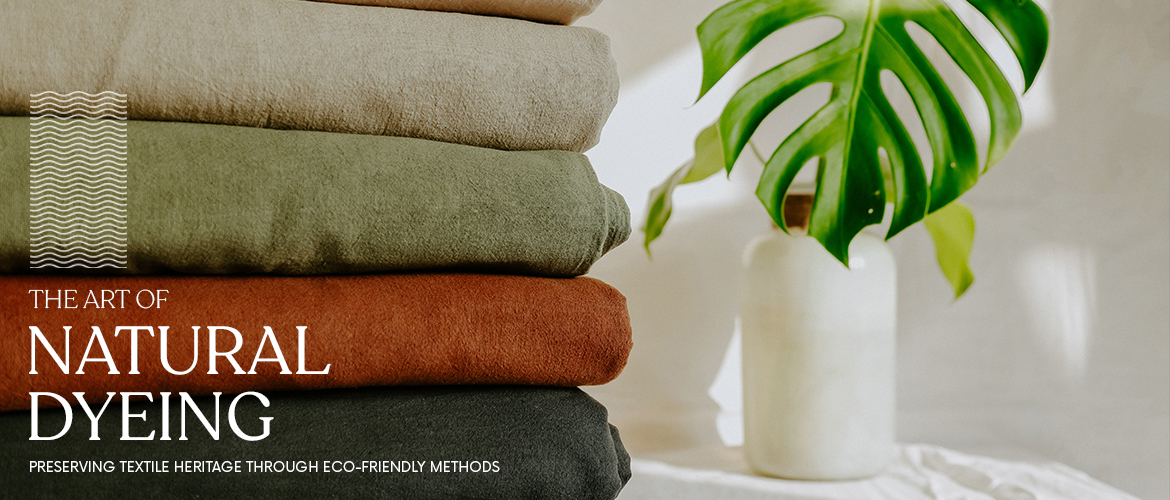{{item.name}}
{{item.attribute}}: {{item.attribute1}}
{{item.attribute2}}: {{item.attribute3}}
Nrs {{item.price}} Nrs {{Number(item.price) - ((Number(item.discount)/100 * Number(item.price)))}} Nrs {{item.price}}
This item is not available now.

They say past is prologue, and that it provides a context and foundation for what is to come in the future. At Sapana Bedsheets, we’ve taken inspiration from the past and resorted to using the traditional technique of natural dyeing to achieve the colours of our 100% cotton bedsheets and pillow covers. By using natural dyes, we not only pay homage to the age-old methods of dyeing but also ensure that our products are environmentally sustainable. Our focus on natural dyeing also ensures that our customers receive a product that is not only visually pleasing but also safe and healthy to use.
About Natural Dyeing
Natural dyeing has a long history, dating back to ancient times. The use of natural dyes can be traced back to the Indus Valley Civilization, where evidence of madder root, turmeric, and indigo dyeing has been found. The art of natural dyeing continued to flourish throughout the centuries, with different regions specializing in the use of particular dyes and techniques. Below, we take a brief look at some of the popular materials used for natural dyeing, and how we implement them at Sapana Bedsheets.
Indigo is a time-honored natural dye that has been used for centuries to create vibrant blue hues in textiles. The source of indigo dye is the Indigofera tinctoria plant, whose leaves undergo a fermentation and oxidation process to create the rich blue color.
The indigo dyeing process requires the use of various natural ingredients, including lime and pomegranate powder, which help to create the ideal conditions for fermentation and oxidation. These ingredients also play a crucial role in enhancing the color and quality of the final product.
At Sapana, we have used this traditional indigo dyeing technique to create our shades of NIilah and Midnight Blue.
_1680657928.jpg)
Our Barsha (Monsoon Cloud) and Jaitoon (Olive) bedsheets are a popular pick amongst our customers, and the primary component in its dyeing process is the myrabolan. Myrabolan is a plant species, recognized as harro in Nepali, which is used in natural dyeing due to its high tannin content. Its fruit is soaked in water to extract the tannins, which can then be used as a mordant for dyeing cotton and silk fabrics with other natural dyes. Myrabolan is known for creating beautiful earthy tones and producing colorfast dyes that resist fading over time.
_1680658977.jpg)
The Dalchini (cinnamon) hue of our bedsheets come from the use of catechu. Catechu (Khayir in Nepali) is a natural dye extracted from the heartwood of the acacia tree. This too has been used for centuries in natural dyeing due to its high tannin content, especially by the indigenous Tharu community of Nepal. The high tannin content acts as a mordant to fix the dye to the fabric. Catechu produces warm, earthy colors such as brown, beige, and yellow.
_1680658180.jpg)
Why we chose natural dyeing at Sapana Bedsheets.
As we become more aware of the impact of synthetic dyes on our environment, it's time for everyone to take responsibility and make a change. At Sapana Bedsheets, we're proud to make a deliberate and conscious decision to use the natural dyeing process in all our products. While it may seem like a small step, we believe it's a step in the right direction towards creating a sustainable future for generations to come.
By using natural dyes, we can directly reduce the release of toxic chemicals associated with synthetic dyes, which are known to be harmful to both human health and the environment. Textile dyeing is currently the second largest water polluter globally. Natural dyes produce vibrant colors and are non-toxic and non-allergenic, unlike chemically dyed or synthetic dyes, which may cause skin diseases and reduce fertility. The residuals from textile manufacturing are often untreated and mixed into rivers, which can be harmful to aquatic life and the environment. Using non-toxic dyeing methods can contribute to eliminating the root cause of toxic residuals.
Additionally, we are committed to supporting local businesses and communities. Our pigments are 90% locally sourced from suppliers from various parts of Nepal. By sourcing locally, we not only reduce our carbon footprint but also support the livelihoods of small-scale farmers and producers.
Also, the process of natural dyeing is labor-intensive. It involves numerous steps, including harvesting and processing the plants, preparing the dye, and dyeing the fabric. Natural dyes are often less colorfast than synthetic dyes. Furthermore, factors like air temperature, sunlight, and humidity play a role in determining the final colour that is achieved. As a result, each batch of fabric has a slightly different shade. However, the beauty and uniqueness of natural dyes make them worth the effort.
At Sapana Bedsheets, we believe that the past can inspire and guide us towards a more sustainable and responsible future. Our natural dyeing technique is just one example of how we are taking a step towards a cleaner and healthier planet.

© 2020 The Local Project. All Rights Reserved
Subscribe to our newsletter to receive news on update.
{{item.attribute}}: {{item.attribute1}}
{{item.attribute2}}: {{item.attribute3}}
Nrs {{item.price}} Nrs {{Number(item.price) - ((Number(item.discount)/100 * Number(item.price)))}} Nrs {{item.price}}
This item is not available now.
{{item.attribute}}: {{item.attribute1}}
{{item.attribute2}}: {{item.attribute3}}
{{item.cartQuantity}} x Nrs {{item.price}} Nrs {{Number(item.price) - ((Number(item.discount)/100 * Number(item.price)))}} Nrs {{item.price}} Out of stock*
This item is not available now.
Subtotal: Nrs {{cartTotal}}
Shipping Inside Kathmandu Valley Only.
